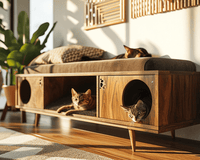Maintaining a pristine litter box area is vital for our beloved feline companions' health. Litter box enclosures, although prized for their practicality, invite ongoing discussions regarding their effects on cats' well-being. These enclosures offer seclusion, yet worries loom regarding their possible influence on feline behavior and health. The desire for an odor-controlled, tidy space must be balanced with understanding the enclosures' impact on cats' comfort. As guardians, it's crucial to delve deeper into this discussion, considering various perspectives to ensure our cats' litter experiences remain harmonious, free of stress, and conducive to their overall health.

Exploring the Pros and Cons
Pros of Litter Box Enclosures:
Privacy and Comfort:
Privacy and Comfort: Enclosures provide cats with a secluded haven, enriching their sense of privacy and security when attending to their litter box needs. These spaces emulate a natural instinct for solitude in cats, reducing stress and promoting a relaxed environment for them to relieve themselves comfortably. The enclosed setting offers a safe retreat, fostering a sense of ownership over their territory, ultimately encouraging consistent litter box usage.

Odor Control:
Enclosures excel in odor management, boasting filters and mechanisms that neutralize odors effectively. These features not only cater to the cats' sensitive noses, ensuring a more pleasant toileting experience, but also ease the concerns of pet owners by maintaining a fresher home environment. By actively trapping and neutralizing odors at the source, these enclosures mitigate any lingering smells, offering a more hygienic and inviting space for both pets and their human companions.
Minimized Litter Tracking:
Minimized Litter Tracking: Enclosures act as effective barriers, confining litter scatter within the enclosed space. By providing a confined area for cats to dig and cover, these enclosures significantly reduce the spread of litter particles across your home. This containment aids in maintaining a tidier and more hygienic living environment, minimizing the need for frequent cleaning due to scattered litter.

Cons and Concerns:
Space Limitations:
Some litter box enclosures, due to their confined space, may inadvertently impose discomfort on cats, potentially leading to reluctance in using the litter box. Cats, known for their preference for open spaces, might feel constrained within compact enclosures, impacting their natural inclination to comfortably maneuver while eliminating. This restriction could result in aversion or stress-related behaviors, emphasizing the importance of selecting spacious enclosures that accommodate a cat's need for freedom of movement.

Ventilation and Air Quality:
Insufficient ventilation within these enclosures can result in elevated humidity levels, potentially creating a breeding ground for bacteria and unpleasant odors. Moreover, inadequate airflow might lead to a buildup of airborne particles, affecting the overall air quality within the confined space. This compromised air circulation could impact the respiratory health of cats, potentially causing discomfort or respiratory issues if not addressed promptly and adequately. Therefore, ensuring proper ventilation becomes imperative in maintaining a healthy and comfortable environment within litter box enclosures.
Behavioral Impact:
Behavioral Impact: Cats, known for their need for space and autonomy, might feel constrained or stressed within enclosed litter box setups. This confinement can potentially disrupt their natural behaviors, leading to reluctance in using the litter box or exhibiting signs of stress. Some cats might express their discomfort through increased vocalization, agitation, or even avoidance of the enclosure altogether. Such stressors could contribute to litter box aversion or, in severe cases, manifest as inappropriate elimination outside the litter box. Ensuring an enclosure that offers sufficient space, comfortable access, and a stress-free environment is pivotal in mitigating any adverse impact on a cat's mental well-being and maintaining healthy litter box habits.

Understanding the Effects on Cats
Individual Suitability:
Cats' acceptance of litter box enclosures varies greatly due to their distinct personalities and habits. Some felines readily embrace the enclosed space, feeling more secure and private during litter box use. However, others might express reluctance or discomfort, requiring a gradual introduction to ensure they adapt positively to the enclosed environment. Understanding each cat's unique preferences remains pivotal in determining the suitability of litter box enclosures.
Size Consideration:
Ensuring sufficient space within the enclosure is crucial to accommodate the cat's movements and natural behaviors comfortably. Cats exhibit various behaviors, including stretching, scratching, and turning around, all of which require ample room. Opt for an enclosure that allows the cat to stand, squat, and pivot comfortably within the litter box area. A spacious environment contributes to their sense of comfort and security, reducing the likelihood of reluctance in using the litter box.

Ventilation Importance:
Ensuring adequate ventilation within a litter box enclosure is paramount. Proper airflow plays a pivotal role in preventing the accumulation of humidity, which, if left unchecked, can create an uncomfortable and potentially unhygienic space for your cat. Adequate ventilation helps maintain a fresh environment, minimizing odors and fostering a more inviting space for your feline companion. It also aids in regulating temperature, contributing to a more comfortable experience while using the litter box enclosure.
Behavioral Observations:
Monitoring your cat's behavior upon introducing the enclosure is crucial for assessing their comfort and acceptance levels. Initially, observe any signs of hesitation or stress when approaching or entering the enclosure. Watch for indicators like reluctance to use the litter box or increased anxiety. Additionally, note any changes in their usual litter box routine or grooming habits, as these could signal discomfort. Regularly assessing their behavior allows for adjustments to ensure a positive and stress-free experience with the enclosure.
Adaptation Period:
Gradual acclimation to the enclosure is vital as it allows the cat to adapt at its own pace, reducing potential stress. Introduce the enclosure by leaving it open and accessible, allowing the cat to explore freely without feeling confined. Gradually close the enclosure's doors over several days, ensuring the cat remains comfortable and doesn't exhibit signs of distress. This patient approach fosters a positive association, encouraging the cat to embrace the enclosure willingly.

Key Considerations When Using Litter Box Enclosures
Size and Accessibility:
Consider the dimensions of the enclosure, ensuring it provides ample space for your cat to maneuver comfortably, stretch, and turn around without feeling confined. Additionally, verify that the entry and exit points are wide enough to accommodate your cat's size and agility, promoting ease of access and encouraging regular use of the litter box.
Ventilation and Airflow:
Selecting well-ventilated enclosures is paramount to ensure a continuous flow of fresh air, preventing humidity buildup and sustaining a pleasant environment. Adequate airflow contributes significantly to the comfort and health of your cat within the enclosure.
Introduction and Acclimation:
To successfully introduce the enclosure, begin by placing it in a familiar area with the door removed, allowing your cat to explore freely. Monitor their reactions, gradually adding the door and observing their comfort level, ensuring a smooth and accepted transition.

Conclusion
In summary, while litter box enclosures present advantages and possible drawbacks for cats, their success depends on how well we accommodate feline needs. Prioritizing your cat's comfort through adequate space, ventilation, and gradual introduction is pivotal. By aligning the enclosure with your cat's preferences and maintaining hygiene, you create an environment where the benefits outweigh the potential issues, fostering a positive and harmonious litter box experience for your furry companion.

FAQs
Q: Can all cats adapt to litter box enclosures?
- Cats' diverse personalities influence their adaptation to enclosures. While some quickly acclimate, others might exhibit initial reluctance. Gradual introduction is crucial, allowing hesitant cats time to familiarize themselves with the enclosure for a smoother transition.
Q: How can I ensure my cat's comfort in an enclosure?
- Ensure your cat's comfort by maintaining a spacious, clean enclosure with proper ventilation, crucial for their well-being and litter box satisfaction.
Q: Will an enclosure solve litter box odor problems completely?
- Although enclosures assist in odor control, consistent cleaning and maintenance are pivotal to effectively manage and diminish lingering odors within the enclosure environment.

Q: Can a litter box enclosure cause health issues for my cat?
- Properly designed and maintained enclosures generally don't cause health problems, but inadequate ventilation might affect air quality.
Q: What if my cat refuses to use the litter box enclosure?
- Although enclosures assist in odor control, consistent cleaning and maintenance are pivotal to effectively manage and diminish lingering odors within the enclosure environment.










